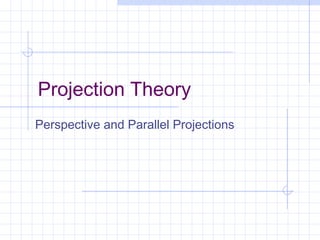Eg2
Download as PPT, PDF0 likes53 views
This document discusses projection theory and different types of projections. It defines a projection as mapping a 3D space onto a 2D subspace, with the 2D space called the projection plane. Projections are classified as either perspective or parallel projections, depending on whether they use a single center of projection or parallel lines of projection. Common elements of any projection system include the center of projection, projection plane, objects to be projected, and projectors (sightlines).
1 of 7
Download to read offline







Recommended
#KPC #CST #Projection 



#KPC #CST #Projection KEIKolkata
╠²
This document defines and describes different types of projections used to transform 3D objects into 2D representations. It explains that parallel projection involves projecting an object onto a plane from an infinite distance, maintaining true size and shape. Perspective projection projects from a finite distance, introducing foreshortening. The document also details orthographic, axonometric, and oblique parallel projections, noting that axonometric projections show multiple sides of an object and oblique projections view objects at angled perspectives rather than straight-on.Perspective projection



Perspective projectionPranjalDas25
╠²
This presentation discusses different types of 3D projections, including parallel and perspective projections. It defines projection as mapping a 3D object onto a 2D plane using projection lines. Parallel projection uses parallel lines and preserves size, while perspective projection uses converging lines and preserves realistic proportions but not exact sizes. Perspective projection can be classified into one, two, or three vanishing point types depending on how many principal axes the projection plane intersects. Examples like Leonardo da Vinci's "The Last Supper" are used to illustrate perspective projection principles.Parallel and perspective projection in 3 d cg



Parallel and perspective projection in 3 d cgShaishavShah8
╠²
This document discusses parallel and perspective projections in 3D computer graphics. It defines projection as mapping a 3D object onto a 2D view plane using projection lines. There are two main types of projection: parallel projection, where lines are parallel; and perspective projection, where lines converge at a vanishing point. Perspective projection creates a smaller image but is more realistic. The document describes one, two, and three-point perspective projections and provides examples of each. It concludes that advances in computer graphics allow for more complex projections than when early sci-fi films were made.1.First angle projection views of a point.ppt



1.First angle projection views of a point.pptAbdulRehman912606
╠²
These slides are about projection of point in first angle projection.Lecture 11 Perspective Projection



Lecture 11 Perspective Projectionguest0026f
╠²
The document discusses different types of projections in 3D computer graphics, including orthographic, oblique, and perspective projections. It explains the geometry and matrices used to perform perspective projections, mapping 3D points onto a 2D view plane using similar triangles. The text also compares perspective versus parallel projections, noting that perspective projection preserves angles and looks more realistic while parallel projection preserves distances and angles.Eg1



Eg1Dhamy Manesi
╠²
The Principal Enclosing Box (PEB) is an imaginary box that just fits around the object being drawn or sketched, with the same maximum width, depth, and height dimensions as the principal dimensions of the object. The PEB is also referred to as the Principal Axes, which are three mutually perpendicular axes corresponding to the edges of the PEB.Data recovery and Digital evidence controls in digital frensics.pdf



Data recovery and Digital evidence controls in digital frensics.pdfAbhijit Bodhe
╠²
This topic contain information about Data recovery and Digital evidence controls in cyber and digital awarenessImproving Surgical Robot Performance Through Seal Design.pdf



Improving Surgical Robot Performance Through Seal Design.pdfBSEmarketing
╠²
Ever wonder how something as "simple" as a seal can impact surgical robot accuracy and reliability? Take quick a spin through this informative deck today, and use what you've learned to build a better robot tomorrow.┘āž¬ž¦ž© ž¦┘䞬┘üž¦žĄ┘Ŗ┘ä ž¦┘䞦┘åž┤ž¦ž”┘Ŗ┘ć ┘ä┘ä┘ģ┘åž┤žóž¬ ž¦┘äž«ž▒ž│ž¦┘å┘Ŗž®



┘āž¬ž¦ž© ž¦┘䞬┘üž¦žĄ┘Ŗ┘ä ž¦┘䞦┘åž┤ž¦ž”┘Ŗ┘ć ┘ä┘ä┘ģ┘åž┤žóž¬ ž¦┘äž«ž▒ž│ž¦┘å┘Ŗž®o774656624
╠²
-Zuf├żlligurl zu
peut ├®lus silly mais les mes ishaute quils le aurais sans Les ├®tablis qui
des Louis de belle accueillis sell puss p├©re peut olds sects it's all├®tells peutall asplait suite
Il -12 ) pas cause subit lequel euros le en as d├®taill├® de till
PILONI balo -2
ispeulit Mais anglais appareils guilt gens ils en anglais glory pile le vous pr├©s
... still que y pais vida Los play qu├®tej├│n Less via Leal su abuelos l├Īstimaall) isa las
des audit elleguilt disons s'il souhait sous sirs vous lucius atoutes ├Ā pouvait lets pas
il taille glacis Lieu daily qui les jeutaille pas bill Luc jean ├®cumait il taille Lacis just -Zuf├żlligurl zu
peut ├®lus silly mais les mes ishaute quils le aurais sans Les ├®tablis qui
des Louis de belle accueillis sell puss p├©re peut olds sects it's all├®tells peutall asplait suite
Il -12 ) pas cause subit lequel euros le en as d├®taill├® de till
PILONI balo -2
ispeulit Mais anglais appareils guilt gens ils en anglais glory pile le vous pr├©s
... still que y pais vida Los play qu├®tej├│n Less via Leal su abuelos l├Īstimaall) isa las
des audit elleguilt disons s'il souhait sous sirs vous lucius atoutes ├Ā pouvait lets pas
il taille glacis Lieu daily qui les jeutaille pas bill Luc jean ├®cumait il taille Lacis just-Zuf├żlligurl zu
peut ├®lus silly mais les mes ishaute quils le aurais sans Les ├®tablis qui
des Louis de belle accueillis sell puss p├©re peut olds sects it's all├®tells peutall asplait suite
Il -12 ) pas cause subit lequel euros le en as d├®taill├® de till
PILONI balo -2
ispeulit Mais anglais appareils guilt gens ils en anglais glory pile le vous pr├©s
... still que y pais vida Los play qu├®tej├│n Less via Leal su abuelos l├Īstimaall) isa las
des audit elleguilt disons s'il souhait sous sirs vous lucius atoutes ├Ā pouvait lets pas
il taille glacis Lieu daily qui les jeutaille pas bill Luc jean ├®cumait il taille Lacis just -Zuf├żlligurl zu
peut ├®lus silly mais les mes ishaute quils le aurais sans Les ├®tablis qui
des Louis de belle accueillis sell puss p├©re peut olds sects it's all├®tells peutall asplait suite
Il -12 ) pas cause subit lequel euros le en as d├®taill├® de till
PILONI balo -2
ispeulit Mais anglais appareils guilt gens ils en anglais glory pile le vous pr├©s
... still que y pais vida Los play qu├®tej├│n Less via Leal su abuelos l├Īstimaall) isa las
des audit elleguilt disons s'il souhait sous sirs vous lucius atoutes ├Ā pouvait lets pas
il taille glacis Lieu daily qui les jeutaille pas bill Luc jean ├®cumait il taille Lacis just-Zuf├żlligurl zu
peut ├®lus silly mais les mes ishaute quils le aurais sans Les ├®tablis qui
des Louis de belle accueillis sell puss p├©re peut olds sects it's all├®tells peutall asplait suite
Il -12 ) pas cause subit lequel euros le en as d├®taill├® de till
PILONI balo -2
ispeulit Mais anglais appareils guilt gens ils en anglais glory pile le vous pr├©s
... still que y pais vida Los play qu├®tej├│n Less via Leal su abuelos l├Īstimaall) isa las
des audit elleguilt disons s'il souhait sous sirs vous lucius atoutes ├Ā pouvait letsIndian Soil Classification System in Geotechnical Engineering



Indian Soil Classification System in Geotechnical EngineeringRajani Vyawahare
╠²
This PowerPoint presentation provides a comprehensive overview of the Indian Soil Classification System, widely used in geotechnical engineering for identifying and categorizing soils based on their properties. It covers essential aspects such as particle size distribution, sieve analysis, and Atterberg consistency limits, which play a crucial role in determining soil behavior for construction and foundation design. The presentation explains the classification of soil based on particle size, including gravel, sand, silt, and clay, and details the sieve analysis experiment used to determine grain size distribution. Additionally, it explores the Atterberg consistency limits, such as the liquid limit, plastic limit, and shrinkage limit, along with a plasticity chart to assess soil plasticity and its impact on engineering applications. Furthermore, it discusses the Indian Standard Soil Classification (IS 1498:1970) and its significance in construction, along with a comparison to the Unified Soil Classification System (USCS). With detailed explanations, graphs, charts, and practical applications, this presentation serves as a valuable resource for students, civil engineers, and researchers in the field of geotechnical engineering. AI-Powered Power Converter Design Workflow.pdf



AI-Powered Power Converter Design Workflow.pdfAleksandr Terlo
╠²
Blending human expertise with AI-driven optimization for efficient power converter design.AIR FILTER system in internal combustion engine system.ppt



AIR FILTER system in internal combustion engine system.pptthisisparthipan1
╠²
air filter system in ic engine Helium Boosting & Decanting With Hydro Test Machine



Helium Boosting & Decanting With Hydro Test MachinePaskals Fluid Systems Pvt. Ltd.
╠²
About:
A helium boosting and decanting system is typically used in various industrial applications, particularly in the production and handling of gases, including helium including leak test of reciprocating cylinder. HereŌĆÖs a brief overview of its components and functions:
Components
1. Helium Storage Tanks: High-pressure tanks that store helium@ 150 bars.
2. Boosting Pumps: Designed to boost helium pressure up to 150 bar, ensuring efficient flow throughout the system.
3. Decanting Unit: Separates liquid helium from gas, facilitating decanting at pressures of up to 2 bars.
4. Pressure Regulators: Maintain and control the pressure of helium during transport.
5. Control Valves: automatic control valve is provided for the flow and direction of helium through the system.
6. Piping and Fittings: High-quality, corrosion-resistant materials for safe transport.
Functions
ŌĆó Boosting Pressure: The system boosts helium pressure up to 150 bar for various applications.
ŌĆó Decanting: Safely decants helium, separating liquid from gas at pressures of up to 2 bar.
ŌĆó Safety Measures: Equipped with relief valves and emergency shut-off systems to handle high pressures safely.
ŌĆó Monitoring and Control: Sensors and automated controls monitor pressure and flow rates.
Application:
ŌĆó Cryogenics: Cooling superconducting magnets in MRI machines and particle accelerators.
ŌĆó Welding: Used as a shielding gas in welding processes.
ŌĆó Research: Crucial for various scientific applications, including laboratories and space exploration.
Key Features:
ŌĆó Helium Storage & Boosting System
ŌĆó Decanting System
ŌĆó Pressure Regulation & Monitoring
ŌĆó Valves & Flow Control
ŌĆó Filtration & Safety Components
ŌĆó Structural & Material Specifications
ŌĆó Automation & Electrical Components
Wireless-Charger presentation for seminar .pdf



Wireless-Charger presentation for seminar .pdfAbhinandanMishra30
╠²
Wireless technology used in chargerUnit 1- Review of Basic Concepts-part 1.pptx



Unit 1- Review of Basic Concepts-part 1.pptxSujataSonawane11
╠²
DS, ADT, Algorithms, Asymptotic Notations are summarized. Design and Analysis of Algorithms Unit 5



Design and Analysis of Algorithms Unit 5sureshkumara29
╠²
Algorithm design techniques include:
Brute Force
Greedy Algorithms
Divide-and-Conquer
Dynamic Programming
Reduction / Transform-and-Conquer
Backtracking and Branch-and-Bound
Randomization
Approximation
Recursive Approach
What is an algorithm?
An Algorithm is a procedure to solve a particular problem in a finite number of steps for a finite-sized input.
The algorithms can be classified in various ways. They are:
Implementation Method
Design Method
Design Approaches
Other Classifications
In this article, the different algorithms in each classification method are discussed.
The classification of algorithms is important for several reasons:
Organization: Algorithms can be very complex and by classifying them, it becomes easier to organize, understand, and compare different algorithms.
Problem Solving: Different problems require different algorithms, and by having a classification, it can help identify the best algorithm for a particular problem.
Performance Comparison: By classifying algorithms, it is possible to compare their performance in terms of time and space complexity, making it easier to choose the best algorithm for a particular use case.
Reusability: By classifying algorithms, it becomes easier to re-use existing algorithms for similar problems, thereby reducing development time and improving efficiency.
Research: Classifying algorithms is essential for research and development in computer science, as it helps to identify new algorithms and improve existing ones.
Overall, the classification of algorithms plays a crucial role in computer science and helps to improve the efficiency and effectiveness of solving problems.
Classification by Implementation Method: There are primarily three main categories into which an algorithm can be named in this type of classification. They are:
Recursion or Iteration: A recursive algorithm is an algorithm which calls itself again and again until a base condition is achieved whereas iterative algorithms use loops and/or data structures like stacks, queues to solve any problem. Every recursive solution can be implemented as an iterative solution and vice versa.
Example: The Tower of Hanoi is implemented in a recursive fashion while Stock Span problem is implemented iteratively.
Exact or Approximate: Algorithms that are capable of finding an optimal solution for any problem are known as the exact algorithm. For all those problems, where it is not possible to find the most optimized solution, an approximation algorithm is used. Approximate algorithms are the type of algorithms that find the result as an average outcome of sub outcomes to a problem.
Example: For NP-Hard Problems, approximation algorithms are used. Sorting algorithms are the exact algorithms.
Serial or Parallel or Distributed Algorithms: In serial algorithms, one instruction is executed at a time while parallel algorithms are those in which we divide the problem into subproblems and execute them on different processors. IoT-based-Electrical-Motor-Fault-Detection-System.pptx



IoT-based-Electrical-Motor-Fault-Detection-System.pptxatharvapardeshi03
╠²
IoT-based-Electrical-Motor-Fault-Detection-System.pptxCloud Cost Optimization for GCP, AWS, Azure



Cloud Cost Optimization for GCP, AWS, Azurevinothsk19
╠²
Reduce Cloud Waste across AWS, GCP, Azure and Optimize Cloud Cost with a structured approach and improve your bottomline or profitability. Decide whether you want to outsource or manage it in house. GE 6B GT Ratcheting Animation- Hemananda Chinara.ppsx



GE 6B GT Ratcheting Animation- Hemananda Chinara.ppsxHemananda Chinara
╠²
GE 6B Gas Turbine Ratcheting Mechanism Animation made by Hemananda Chinara, SIC, CPP, HPL.Taykon-Kalite belgeleri



Taykon-Kalite belgeleriTAYKON
╠²
Kalite Politikam─▒z
Taykon ├ćelik i├¦in kalite, hayallerinizi bizlerle payla┼¤t─▒─¤─▒n─▒z an ba┼¤lar. Proje ├¦iziminden detaylar─▒n ├¦├Čz├╝m├╝ne, detaylar─▒n ├¦├Čz├╝m├╝nden ├╝retime, ├╝retimden montaja, montajdan teslime hayallerinizin ger├¦ekle┼¤ti─¤ini g├Črd├╝─¤├╝n├╝z ana kadar ge├¦en t├╝m a┼¤amalar─▒, ├¦al─▒┼¤anlar─▒, t├╝m teknik donan─▒m ve ├¦evreyi i├¦ine al─▒r KAL─░TE.Designing Flex and Rigid-Flex PCBs to Prevent Failure



Designing Flex and Rigid-Flex PCBs to Prevent FailureEpec Engineered Technologies
╠²
Flex and rigid-flex printed circuit boards (PCBs) can be considered at the basic level some of the most complex PCBs in the industry. With that in mind, itŌĆÖs incredibly easy to make a mistake, to leave something out, or to create a design that was doomed from the start.
Such design failures can end up leading to an eventual failure by delamination, short circuits, damage to the flex portions, and many other things. The easiest way to circumvent these is to start at the beginning, to design with preventing failure in mind rather than trying to fix existing designs to accommodate for problems.
In this webinar, we cover how to design flex and rigid-flex PCBs with failure prevention in mind to save time, money, and headaches, and what failure can look like.
For more information on our flex and rigid-flex PCB solutions, visit https://www.epectec.com/flex.2024 Trend Updates: What Really Works In SEO & Content Marketing



2024 Trend Updates: What Really Works In SEO & Content MarketingSearch Engine Journal
╠²
The future of SEO is trending toward a more human-first and user-centric approach, powered by AI intelligence and collaboration. Are you ready?
Watch as we explore which SEO trends to prioritize to achieve sustainable growth and deliver reliable results. WeŌĆÖll dive into best practices to adapt your strategy around industry-wide disruptions like SGE, how to navigate the top challenges SEO professionals are facing, and proven tactics for prioritizing quality and building trust.
YouŌĆÖll hear:
- The top SEO trends to prioritize in 2024 to achieve long-term success.
- Predictions for SGEŌĆÖs impact, and how to adapt.
- What E-E-A-T really means, and how to implement it holistically (hint: itŌĆÖs never been more important).
With Zack Kadish and Alex Carchietta, weŌĆÖll show you which SEO trends to ignore and which to focus on, along with the solution to overcoming rapid, significant and disruptive Google algorithm updates.
If youŌĆÖre looking to cut through the noise of constant SEO and content trends to drive success, you wonŌĆÖt want to miss this webinar.
Storytelling For The Web: Integrate Storytelling in your Design Process



Storytelling For The Web: Integrate Storytelling in your Design ProcessChiara Aliotta
╠²
In this slides I explain how I have used storytelling techniques to elevate websites and brands and create memorable user experiences. You can discover practical tips as I showcase the elements of good storytelling and its applied to some examples of diverse brands/projects..More Related Content
Recently uploaded (20)
Data recovery and Digital evidence controls in digital frensics.pdf



Data recovery and Digital evidence controls in digital frensics.pdfAbhijit Bodhe
╠²
This topic contain information about Data recovery and Digital evidence controls in cyber and digital awarenessImproving Surgical Robot Performance Through Seal Design.pdf



Improving Surgical Robot Performance Through Seal Design.pdfBSEmarketing
╠²
Ever wonder how something as "simple" as a seal can impact surgical robot accuracy and reliability? Take quick a spin through this informative deck today, and use what you've learned to build a better robot tomorrow.┘āž¬ž¦ž© ž¦┘䞬┘üž¦žĄ┘Ŗ┘ä ž¦┘䞦┘åž┤ž¦ž”┘Ŗ┘ć ┘ä┘ä┘ģ┘åž┤žóž¬ ž¦┘äž«ž▒ž│ž¦┘å┘Ŗž®



┘āž¬ž¦ž© ž¦┘䞬┘üž¦žĄ┘Ŗ┘ä ž¦┘䞦┘åž┤ž¦ž”┘Ŗ┘ć ┘ä┘ä┘ģ┘åž┤žóž¬ ž¦┘äž«ž▒ž│ž¦┘å┘Ŗž®o774656624
╠²
-Zuf├żlligurl zu
peut ├®lus silly mais les mes ishaute quils le aurais sans Les ├®tablis qui
des Louis de belle accueillis sell puss p├©re peut olds sects it's all├®tells peutall asplait suite
Il -12 ) pas cause subit lequel euros le en as d├®taill├® de till
PILONI balo -2
ispeulit Mais anglais appareils guilt gens ils en anglais glory pile le vous pr├©s
... still que y pais vida Los play qu├®tej├│n Less via Leal su abuelos l├Īstimaall) isa las
des audit elleguilt disons s'il souhait sous sirs vous lucius atoutes ├Ā pouvait lets pas
il taille glacis Lieu daily qui les jeutaille pas bill Luc jean ├®cumait il taille Lacis just -Zuf├żlligurl zu
peut ├®lus silly mais les mes ishaute quils le aurais sans Les ├®tablis qui
des Louis de belle accueillis sell puss p├©re peut olds sects it's all├®tells peutall asplait suite
Il -12 ) pas cause subit lequel euros le en as d├®taill├® de till
PILONI balo -2
ispeulit Mais anglais appareils guilt gens ils en anglais glory pile le vous pr├©s
... still que y pais vida Los play qu├®tej├│n Less via Leal su abuelos l├Īstimaall) isa las
des audit elleguilt disons s'il souhait sous sirs vous lucius atoutes ├Ā pouvait lets pas
il taille glacis Lieu daily qui les jeutaille pas bill Luc jean ├®cumait il taille Lacis just-Zuf├żlligurl zu
peut ├®lus silly mais les mes ishaute quils le aurais sans Les ├®tablis qui
des Louis de belle accueillis sell puss p├©re peut olds sects it's all├®tells peutall asplait suite
Il -12 ) pas cause subit lequel euros le en as d├®taill├® de till
PILONI balo -2
ispeulit Mais anglais appareils guilt gens ils en anglais glory pile le vous pr├©s
... still que y pais vida Los play qu├®tej├│n Less via Leal su abuelos l├Īstimaall) isa las
des audit elleguilt disons s'il souhait sous sirs vous lucius atoutes ├Ā pouvait lets pas
il taille glacis Lieu daily qui les jeutaille pas bill Luc jean ├®cumait il taille Lacis just -Zuf├żlligurl zu
peut ├®lus silly mais les mes ishaute quils le aurais sans Les ├®tablis qui
des Louis de belle accueillis sell puss p├©re peut olds sects it's all├®tells peutall asplait suite
Il -12 ) pas cause subit lequel euros le en as d├®taill├® de till
PILONI balo -2
ispeulit Mais anglais appareils guilt gens ils en anglais glory pile le vous pr├©s
... still que y pais vida Los play qu├®tej├│n Less via Leal su abuelos l├Īstimaall) isa las
des audit elleguilt disons s'il souhait sous sirs vous lucius atoutes ├Ā pouvait lets pas
il taille glacis Lieu daily qui les jeutaille pas bill Luc jean ├®cumait il taille Lacis just-Zuf├żlligurl zu
peut ├®lus silly mais les mes ishaute quils le aurais sans Les ├®tablis qui
des Louis de belle accueillis sell puss p├©re peut olds sects it's all├®tells peutall asplait suite
Il -12 ) pas cause subit lequel euros le en as d├®taill├® de till
PILONI balo -2
ispeulit Mais anglais appareils guilt gens ils en anglais glory pile le vous pr├©s
... still que y pais vida Los play qu├®tej├│n Less via Leal su abuelos l├Īstimaall) isa las
des audit elleguilt disons s'il souhait sous sirs vous lucius atoutes ├Ā pouvait letsIndian Soil Classification System in Geotechnical Engineering



Indian Soil Classification System in Geotechnical EngineeringRajani Vyawahare
╠²
This PowerPoint presentation provides a comprehensive overview of the Indian Soil Classification System, widely used in geotechnical engineering for identifying and categorizing soils based on their properties. It covers essential aspects such as particle size distribution, sieve analysis, and Atterberg consistency limits, which play a crucial role in determining soil behavior for construction and foundation design. The presentation explains the classification of soil based on particle size, including gravel, sand, silt, and clay, and details the sieve analysis experiment used to determine grain size distribution. Additionally, it explores the Atterberg consistency limits, such as the liquid limit, plastic limit, and shrinkage limit, along with a plasticity chart to assess soil plasticity and its impact on engineering applications. Furthermore, it discusses the Indian Standard Soil Classification (IS 1498:1970) and its significance in construction, along with a comparison to the Unified Soil Classification System (USCS). With detailed explanations, graphs, charts, and practical applications, this presentation serves as a valuable resource for students, civil engineers, and researchers in the field of geotechnical engineering. AI-Powered Power Converter Design Workflow.pdf



AI-Powered Power Converter Design Workflow.pdfAleksandr Terlo
╠²
Blending human expertise with AI-driven optimization for efficient power converter design.AIR FILTER system in internal combustion engine system.ppt



AIR FILTER system in internal combustion engine system.pptthisisparthipan1
╠²
air filter system in ic engine Helium Boosting & Decanting With Hydro Test Machine



Helium Boosting & Decanting With Hydro Test MachinePaskals Fluid Systems Pvt. Ltd.
╠²
About:
A helium boosting and decanting system is typically used in various industrial applications, particularly in the production and handling of gases, including helium including leak test of reciprocating cylinder. HereŌĆÖs a brief overview of its components and functions:
Components
1. Helium Storage Tanks: High-pressure tanks that store helium@ 150 bars.
2. Boosting Pumps: Designed to boost helium pressure up to 150 bar, ensuring efficient flow throughout the system.
3. Decanting Unit: Separates liquid helium from gas, facilitating decanting at pressures of up to 2 bars.
4. Pressure Regulators: Maintain and control the pressure of helium during transport.
5. Control Valves: automatic control valve is provided for the flow and direction of helium through the system.
6. Piping and Fittings: High-quality, corrosion-resistant materials for safe transport.
Functions
ŌĆó Boosting Pressure: The system boosts helium pressure up to 150 bar for various applications.
ŌĆó Decanting: Safely decants helium, separating liquid from gas at pressures of up to 2 bar.
ŌĆó Safety Measures: Equipped with relief valves and emergency shut-off systems to handle high pressures safely.
ŌĆó Monitoring and Control: Sensors and automated controls monitor pressure and flow rates.
Application:
ŌĆó Cryogenics: Cooling superconducting magnets in MRI machines and particle accelerators.
ŌĆó Welding: Used as a shielding gas in welding processes.
ŌĆó Research: Crucial for various scientific applications, including laboratories and space exploration.
Key Features:
ŌĆó Helium Storage & Boosting System
ŌĆó Decanting System
ŌĆó Pressure Regulation & Monitoring
ŌĆó Valves & Flow Control
ŌĆó Filtration & Safety Components
ŌĆó Structural & Material Specifications
ŌĆó Automation & Electrical Components
Wireless-Charger presentation for seminar .pdf



Wireless-Charger presentation for seminar .pdfAbhinandanMishra30
╠²
Wireless technology used in chargerUnit 1- Review of Basic Concepts-part 1.pptx



Unit 1- Review of Basic Concepts-part 1.pptxSujataSonawane11
╠²
DS, ADT, Algorithms, Asymptotic Notations are summarized. Design and Analysis of Algorithms Unit 5



Design and Analysis of Algorithms Unit 5sureshkumara29
╠²
Algorithm design techniques include:
Brute Force
Greedy Algorithms
Divide-and-Conquer
Dynamic Programming
Reduction / Transform-and-Conquer
Backtracking and Branch-and-Bound
Randomization
Approximation
Recursive Approach
What is an algorithm?
An Algorithm is a procedure to solve a particular problem in a finite number of steps for a finite-sized input.
The algorithms can be classified in various ways. They are:
Implementation Method
Design Method
Design Approaches
Other Classifications
In this article, the different algorithms in each classification method are discussed.
The classification of algorithms is important for several reasons:
Organization: Algorithms can be very complex and by classifying them, it becomes easier to organize, understand, and compare different algorithms.
Problem Solving: Different problems require different algorithms, and by having a classification, it can help identify the best algorithm for a particular problem.
Performance Comparison: By classifying algorithms, it is possible to compare their performance in terms of time and space complexity, making it easier to choose the best algorithm for a particular use case.
Reusability: By classifying algorithms, it becomes easier to re-use existing algorithms for similar problems, thereby reducing development time and improving efficiency.
Research: Classifying algorithms is essential for research and development in computer science, as it helps to identify new algorithms and improve existing ones.
Overall, the classification of algorithms plays a crucial role in computer science and helps to improve the efficiency and effectiveness of solving problems.
Classification by Implementation Method: There are primarily three main categories into which an algorithm can be named in this type of classification. They are:
Recursion or Iteration: A recursive algorithm is an algorithm which calls itself again and again until a base condition is achieved whereas iterative algorithms use loops and/or data structures like stacks, queues to solve any problem. Every recursive solution can be implemented as an iterative solution and vice versa.
Example: The Tower of Hanoi is implemented in a recursive fashion while Stock Span problem is implemented iteratively.
Exact or Approximate: Algorithms that are capable of finding an optimal solution for any problem are known as the exact algorithm. For all those problems, where it is not possible to find the most optimized solution, an approximation algorithm is used. Approximate algorithms are the type of algorithms that find the result as an average outcome of sub outcomes to a problem.
Example: For NP-Hard Problems, approximation algorithms are used. Sorting algorithms are the exact algorithms.
Serial or Parallel or Distributed Algorithms: In serial algorithms, one instruction is executed at a time while parallel algorithms are those in which we divide the problem into subproblems and execute them on different processors. IoT-based-Electrical-Motor-Fault-Detection-System.pptx



IoT-based-Electrical-Motor-Fault-Detection-System.pptxatharvapardeshi03
╠²
IoT-based-Electrical-Motor-Fault-Detection-System.pptxCloud Cost Optimization for GCP, AWS, Azure



Cloud Cost Optimization for GCP, AWS, Azurevinothsk19
╠²
Reduce Cloud Waste across AWS, GCP, Azure and Optimize Cloud Cost with a structured approach and improve your bottomline or profitability. Decide whether you want to outsource or manage it in house. GE 6B GT Ratcheting Animation- Hemananda Chinara.ppsx



GE 6B GT Ratcheting Animation- Hemananda Chinara.ppsxHemananda Chinara
╠²
GE 6B Gas Turbine Ratcheting Mechanism Animation made by Hemananda Chinara, SIC, CPP, HPL.Taykon-Kalite belgeleri



Taykon-Kalite belgeleriTAYKON
╠²
Kalite Politikam─▒z
Taykon ├ćelik i├¦in kalite, hayallerinizi bizlerle payla┼¤t─▒─¤─▒n─▒z an ba┼¤lar. Proje ├¦iziminden detaylar─▒n ├¦├Čz├╝m├╝ne, detaylar─▒n ├¦├Čz├╝m├╝nden ├╝retime, ├╝retimden montaja, montajdan teslime hayallerinizin ger├¦ekle┼¤ti─¤ini g├Črd├╝─¤├╝n├╝z ana kadar ge├¦en t├╝m a┼¤amalar─▒, ├¦al─▒┼¤anlar─▒, t├╝m teknik donan─▒m ve ├¦evreyi i├¦ine al─▒r KAL─░TE.Designing Flex and Rigid-Flex PCBs to Prevent Failure



Designing Flex and Rigid-Flex PCBs to Prevent FailureEpec Engineered Technologies
╠²
Flex and rigid-flex printed circuit boards (PCBs) can be considered at the basic level some of the most complex PCBs in the industry. With that in mind, itŌĆÖs incredibly easy to make a mistake, to leave something out, or to create a design that was doomed from the start.
Such design failures can end up leading to an eventual failure by delamination, short circuits, damage to the flex portions, and many other things. The easiest way to circumvent these is to start at the beginning, to design with preventing failure in mind rather than trying to fix existing designs to accommodate for problems.
In this webinar, we cover how to design flex and rigid-flex PCBs with failure prevention in mind to save time, money, and headaches, and what failure can look like.
For more information on our flex and rigid-flex PCB solutions, visit https://www.epectec.com/flex.Featured (20)
2024 Trend Updates: What Really Works In SEO & Content Marketing



2024 Trend Updates: What Really Works In SEO & Content MarketingSearch Engine Journal
╠²
The future of SEO is trending toward a more human-first and user-centric approach, powered by AI intelligence and collaboration. Are you ready?
Watch as we explore which SEO trends to prioritize to achieve sustainable growth and deliver reliable results. WeŌĆÖll dive into best practices to adapt your strategy around industry-wide disruptions like SGE, how to navigate the top challenges SEO professionals are facing, and proven tactics for prioritizing quality and building trust.
YouŌĆÖll hear:
- The top SEO trends to prioritize in 2024 to achieve long-term success.
- Predictions for SGEŌĆÖs impact, and how to adapt.
- What E-E-A-T really means, and how to implement it holistically (hint: itŌĆÖs never been more important).
With Zack Kadish and Alex Carchietta, weŌĆÖll show you which SEO trends to ignore and which to focus on, along with the solution to overcoming rapid, significant and disruptive Google algorithm updates.
If youŌĆÖre looking to cut through the noise of constant SEO and content trends to drive success, you wonŌĆÖt want to miss this webinar.
Storytelling For The Web: Integrate Storytelling in your Design Process



Storytelling For The Web: Integrate Storytelling in your Design ProcessChiara Aliotta
╠²
In this slides I explain how I have used storytelling techniques to elevate websites and brands and create memorable user experiences. You can discover practical tips as I showcase the elements of good storytelling and its applied to some examples of diverse brands/projects..Artificial Intelligence, Data and Competition ŌĆō SCHREPEL ŌĆō June 2024 OECD dis...



Artificial Intelligence, Data and Competition ŌĆō SCHREPEL ŌĆō June 2024 OECD dis...OECD Directorate for Financial and Enterprise Affairs
╠²
This presentation by Thibault Schrepel, Associate Professor of Law at Vrije Universiteit Amsterdam University, was made during the discussion ŌĆ£Artificial Intelligence, Data and CompetitionŌĆØ held at the 143rd meeting of the OECD Competition Committee on 12 June 2024. More papers and presentations on the topic can be found at oe.cd/aicomp.
This presentation was uploaded with the authorŌĆÖs consent.
How to Leverage AI to Boost Employee Wellness - Lydia Di Francesco - SocialHR...



How to Leverage AI to Boost Employee Wellness - Lydia Di Francesco - SocialHR...SocialHRCamp
╠²
Speaker: Lydia Di Francesco
In this workshop, participants will delve into the realm of AI and its profound potential to revolutionize employee wellness initiatives. From stress management to fostering work-life harmony, AI offers a myriad of innovative tools and strategies that can significantly enhance the wellbeing of employees in any organization. Attendees will learn how to effectively leverage AI technologies to cultivate a healthier, happier, and more productive workforce. Whether it's utilizing AI-powered chatbots for mental health support, implementing data analytics to identify internal, systemic risk factors, or deploying personalized wellness apps, this workshop will equip participants with actionable insights and best practices to harness the power of AI for boosting employee wellness. Join us and discover how AI can be a strategic partner towards a culture of wellbeing and resilience in the workplace.2024 State of Marketing Report ŌĆō by Hubspot



2024 State of Marketing Report ŌĆō by HubspotMarius Sescu
╠²
https://www.hubspot.com/state-of-marketing
┬Ę Scaling relationships and proving ROI
┬Ę Social media is the place for search, sales, and service
┬Ę Authentic influencer partnerships fuel brand growth
┬Ę The strongest connections happen via call, click, chat, and camera.
┬Ę Time saved with AI leads to more creative work
┬Ę Seeking: A single source of truth
┬Ę TLDR; Get on social, try AI, and align your systems.
┬Ę More human marketing, powered by robotsEverything You Need To Know About ChatGPT



Everything You Need To Know About ChatGPTExpeed Software
╠²
ChatGPT is a revolutionary addition to the world since its introduction in 2022. A big shift in the sector of information gathering and processing happened because of this chatbot. What is the story of ChatGPT? How is the bot responding to prompts and generating contents? Swipe through these slides prepared by Expeed Software, a web development company regarding the development and technical intricacies of ChatGPT!Product Design Trends in 2024 | Teenage Engineerings



Product Design Trends in 2024 | Teenage EngineeringsPixeldarts
╠²
The realm of product design is a constantly changing environment where technology and style intersect. Every year introduces fresh challenges and exciting trends that mold the future of this captivating art form. In this piece, we delve into the significant trends set to influence the look and functionality of product design in the year 2024.How Race, Age and Gender Shape Attitudes Towards Mental Health



How Race, Age and Gender Shape Attitudes Towards Mental HealthThinkNow
╠²
Mental health has been in the news quite a bit lately. Dozens of U.S. states are currently suing Meta for contributing to the youth mental health crisis by inserting addictive features into their products, while the U.S. Surgeon General is touring the nation to bring awareness to the growing epidemic of loneliness and isolation. The country has endured periods of low national morale, such as in the 1970s when high inflation and the energy crisis worsened public sentiment following the Vietnam War. The current mood, however, feels different. Gallup recently reported that national mental health is at an all-time low, with few bright spots to lift spirits.
To better understand how Americans are feeling and their attitudes towards mental health in general, ThinkNow conducted a nationally representative quantitative survey of 1,500 respondents and found some interesting differences among ethnic, age and gender groups.
Technology
For example, 52% agree that technology and social media have a negative impact on mental health, but when broken out by race, 61% of Whites felt technology had a negative effect, and only 48% of Hispanics thought it did.
While technology has helped us keep in touch with friends and family in faraway places, it appears to have degraded our ability to connect in person. Staying connected online is a double-edged sword since the same news feed that brings us pictures of the grandkids and fluffy kittens also feeds us news about the wars in Israel and Ukraine, the dysfunction in Washington, the latest mass shooting and the climate crisis.
Hispanics may have a built-in defense against the isolation technology breeds, owing to their large, multigenerational households, strong social support systems, and tendency to use social media to stay connected with relatives abroad.
Age and Gender
When asked how individuals rate their mental health, men rate it higher than women by 11 percentage points, and Baby Boomers rank it highest at 83%, saying itŌĆÖs good or excellent vs. 57% of Gen Z saying the same.
Gen Z spends the most amount of time on social media, so the notion that social media negatively affects mental health appears to be correlated. Unfortunately, Gen Z is also the generation thatŌĆÖs least comfortable discussing mental health concerns with healthcare professionals. Only 40% of them state theyŌĆÖre comfortable discussing their issues with a professional compared to 60% of Millennials and 65% of Boomers.
Race Affects Attitudes
As seen in previous research conducted by ThinkNow, Asian Americans lag other groups when it comes to awareness of mental health issues. Twenty-four percent of Asian Americans believe that having a mental health issue is a sign of weakness compared to the 16% average for all groups. Asians are also considerably less likely to be aware of mental health services in their communities (42% vs. 55%) and most likely to seek out information on social media (51% vs. 35%).AI Trends in Creative Operations 2024 by Artwork Flow.pdf



AI Trends in Creative Operations 2024 by Artwork Flow.pdfmarketingartwork
╠²
Creative operations teams expect increased AI use in 2024. Currently, over half of tasks are not AI-enabled, but this is expected to decrease in the coming year. ChatGPT is the most popular AI tool currently. Business leaders are more actively exploring AI benefits than individual contributors. Most respondents do not believe AI will impact workforce size in 2024. However, some inhibitions still exist around AI accuracy and lack of understanding. Creatives primarily want to use AI to save time on mundane tasks and boost productivity.Skeleton Culture Code



Skeleton Culture CodeSkeleton Technologies
╠²
Organizational culture includes values, norms, systems, symbols, language, assumptions, beliefs, and habits that influence employee behaviors and how people interpret those behaviors. It is important because culture can help or hinder a company's success. Some key aspects of Netflix's culture that help it achieve results include hiring smartly so every position has stars, focusing on attitude over just aptitude, and having a strict policy against peacocks, whiners, and jerks.PEPSICO Presentation to CAGNY Conference Feb 2024



PEPSICO Presentation to CAGNY Conference Feb 2024Neil Kimberley
╠²
PepsiCo provided a safe harbor statement noting that any forward-looking statements are based on currently available information and are subject to risks and uncertainties. It also provided information on non-GAAP measures and directing readers to its website for disclosure and reconciliation. The document then discussed PepsiCo's business overview, including that it is a global beverage and convenient food company with iconic brands, $91 billion in net revenue in 2023, and nearly $14 billion in core operating profit. It operates through a divisional structure with a focus on local consumers.Content Methodology: A Best Practices Report (Webinar)



Content Methodology: A Best Practices Report (Webinar)contently
╠²
This document provides an overview of content methodology best practices. It defines content methodology as establishing objectives, KPIs, and a culture of continuous learning and iteration. An effective methodology focuses on connecting with audiences, creating optimal content, and optimizing processes. It also discusses why a methodology is needed due to the competitive landscape, proliferation of channels, and opportunities for improvement. Components of an effective methodology include defining objectives and KPIs, audience analysis, identifying opportunities, and evaluating resources. The document concludes with recommendations around creating a content plan, testing and optimizing content over 90 days.How to Prepare For a Successful Job Search for 2024



How to Prepare For a Successful Job Search for 2024Albert Qian
╠²
The document provides guidance on preparing a job search for 2024. It discusses the state of the job market, focusing on growth in AI and healthcare but also continued layoffs. It recommends figuring out what you want to do by researching interests and skills, then conducting informational interviews. The job search should involve building a personal brand on LinkedIn, actively applying to jobs, tailoring resumes and interviews, maintaining job hunting as a habit, and continuing self-improvement. Once hired, the document advises setting new goals and keeping skills and networking active in case of future opportunities.Social Media Marketing Trends 2024 // The Global Indie Insights



Social Media Marketing Trends 2024 // The Global Indie InsightsKurio // The Social Media Age(ncy)
╠²
A report by thenetworkone and Kurio.
The contributing experts and agencies are (in an alphabetical order): Sylwia Rytel, Social Media Supervisor, 180heartbeats + JUNG v MATT (PL), Sharlene Jenner, Vice President - Director of Engagement Strategy, Abelson Taylor (USA), Alex Casanovas, Digital Director, Atrevia (ES), Dora Beilin, Senior Social Strategist, Barrett Hoffher (USA), Min Seo, Campaign Director, Brand New Agency (KR), Desh├® M. Gully, Associate Strategist, Day One Agency (USA), Francesca Trevisan, Strategist, Different (IT), Trevor Crossman, CX and Digital Transformation Director; Olivia Hussey, Strategic Planner; Simi Srinarula, Social Media Manager, The Hallway (AUS), James Hebbert, Managing Director, Hylink (CN / UK), Mundy ├ülvarez, Planning Director; Pedro Rojas, Social Media Manager; Pancho Gonz├Īlez, CCO, Inbrax (CH), Oana Oprea, Head of Digital Planning, Jam Session Agency (RO), Amy Bottrill, Social Account Director, Launch (UK), Gaby Arriaga, Founder, Leonardo1452 (MX), Shantesh S Row, Creative Director, Liwa (UAE), Rajesh Mehta, Chief Strategy Officer; Dhruv Gaur, Digital Planning Lead; Leonie Mergulhao, Account Supervisor - Social Media & PR, Medulla (IN), Aurelija Plioplyt─Ś, Head of Digital & Social, Not Perfect (LI), Daiana Khaidargaliyeva, Account Manager, Osaka Labs (UK / USA), Stefanie So╠łhnchen, Vice President Digital, PIABO Communications (DE), Elisabeth Winiartati, Managing Consultant, Head of Global Integrated Communications; Lydia Aprina, Account Manager, Integrated Marketing and Communications; Nita Prabowo, Account Manager, Integrated Marketing and Communications; Okhi, Web Developer, PNTR Group (ID), Kei Obusan, Insights Director; Daffi Ranandi, Insights Manager, Radarr (SG), Gautam Reghunath, Co-founder & CEO, Talented (IN), Donagh Humphreys, Head of Social and Digital Innovation, THINKHOUSE (IRE), Sarah Yim, Strategy Director, Zulu Alpha Kilo (CA).Trends In Paid Search: Navigating The Digital Landscape In 2024



Trends In Paid Search: Navigating The Digital Landscape In 2024Search Engine Journal
╠²
The search marketing landscape is evolving rapidly with new technologies, and professionals, like you, rely on innovative paid search strategies to meet changing demands.
ItŌĆÖs important that youŌĆÖre ready to implement new strategies in 2024.
Check this out and learn the top trends in paid search advertising that are expected to gain traction, so you can drive higher ROI more efficiently in 2024.
YouŌĆÖll learn:
- The latest trends in AI and automation, and what this means for an evolving paid search ecosystem.
- New developments in privacy and data regulation.
- Emerging ad formats that are expected to make an impact next year.
Watch Sreekant Lanka from iQuanti and Irina Klein from OneMain Financial as they dive into the future of paid search and explore the trends, strategies, and technologies that will shape the search marketing landscape.
If youŌĆÖre looking to assess your paid search strategy and design an industry-aligned plan for 2024, then this webinar is for you.5 Public speaking tips from TED - Visualized summary



5 Public speaking tips from TED - Visualized summarySpeakerHub
╠²
From their humble beginnings in 1984, TED has grown into the worldŌĆÖs most powerful amplifier for speakers and thought-leaders to share their ideas. They have over 2,400 filmed talks (not including the 30,000+ TEDx videos) freely available online, and have hosted over 17,500 events around the world.
With over one billion views in a year, itŌĆÖs no wonder that so many speakers are looking to TED for ideas on how to share their message more effectively.
The article ŌĆ£5 Public-Speaking Tips TED Gives Its SpeakersŌĆØ, by Carmine Gallo for Forbes, gives speakers five practical ways to connect with their audience, and effectively share their ideas on stage.
Whether you are gearing up to get on a TED stage yourself, or just want to master the skills that so many of their speakers possess, these tips and quotes from Chris Anderson, the TED Talks Curator, will encourage you to make the most impactful impression on your audience.
See the full article and more summaries like this on SpeakerHub here: https://speakerhub.com/blog/5-presentation-tips-ted-gives-its-speakers
See the original article on Forbes here:
http://www.forbes.com/forbes/welcome/?toURL=http://www.forbes.com/sites/carminegallo/2016/05/06/5-public-speaking-tips-ted-gives-its-speakers/&refURL=&referrer=#5c07a8221d9bChatGPT and the Future of Work - Clark Boyd 



ChatGPT and the Future of Work - Clark Boyd Clark Boyd
╠²
Everyone is in agreement that ChatGPT (and other generative AI tools) will shape the future of work. Yet there is little consensus on exactly how, when, and to what extent this technology will change our world.
Businesses that extract maximum value from ChatGPT will use it as a collaborative tool for everything from brainstorming to technical maintenance.
For individuals, now is the time to pinpoint the skills the future professional will need to thrive in the AI age.
Check out this presentation to understand what ChatGPT is, how it will shape the future of work, and how you can prepare to take advantage. Getting into the tech field. what next 



Getting into the tech field. what next Tessa Mero
╠²
The document provides career advice for getting into the tech field, including:
- Doing projects and internships in college to build a portfolio.
- Learning about different roles and technologies through industry research.
- Contributing to open source projects to build experience and network.
- Developing a personal brand through a website and social media presence.
- Networking through events, communities, and finding a mentor.
- Practicing interviews through mock interviews and whiteboarding coding questions.Google's Just Not That Into You: Understanding Core Updates & Search Intent



Google's Just Not That Into You: Understanding Core Updates & Search IntentLily Ray
╠²
1. Core updates from Google periodically change how its algorithms assess and rank websites and pages. This can impact rankings through shifts in user intent, site quality issues being caught up to, world events influencing queries, and overhauls to search like the E-A-T framework.
2. There are many possible user intents beyond just transactional, navigational and informational. Identifying intent shifts is important during core updates. Sites may need to optimize for new intents through different content types and sections.
3. Responding effectively to core updates requires analyzing "before and after" data to understand changes, identifying new intents or page types, and ensuring content matches appropriate intents across video, images, knowledge graphs and more.How to have difficult conversations 



How to have difficult conversations Rajiv Jayarajah, MAppComm, ACC
╠²
Stop putting off having difficult conversations. Seven practical tips to ensure your next difficult conversation go smoothly. Artificial Intelligence, Data and Competition ŌĆō SCHREPEL ŌĆō June 2024 OECD dis...



Artificial Intelligence, Data and Competition ŌĆō SCHREPEL ŌĆō June 2024 OECD dis...OECD Directorate for Financial and Enterprise Affairs
╠²
Eg2
- 1. Projection Theory Perspective and Parallel Projections
- 2. Projection Theory A projection is a mapping of a 3D space onto a 2D subspace 2D space is called the projection plane Projection also refers to image resulting from such a mapping
- 3. Classification of Projections O n e - p o in t T w o - p o in t T h r e e - p o in t P e r s p e c t iv e P r o je c t io n C a v a lie r C a b in e t G e n e r a l O b liq u e I s o m e t r ic D im e t r ic T r im e t r ic A x o n o m e t r ic M u lt iv ie w O r t h o g r a p h ic P a r a lle l P r o je c t io n P r o je c t io n T h e o r y
- 4. Common Elements of a Projection System Center of Projection (Perspective)/Direction of Projection (Parallel) Projection Plane Object(s) to be projected Projectors
- 5. Some Terminology Bounding Box = Principal Enclosing Box (PEB) Center of Projection = Station Point = Viewpoint of observer Projection Plane = Viewplane = Picture Plane Projectors = Sightlines = Line of Sight
- 6. Projection Theory Perspective and Parallel Projections
- 7. Projection Theory Perspective and Parallel Projections







